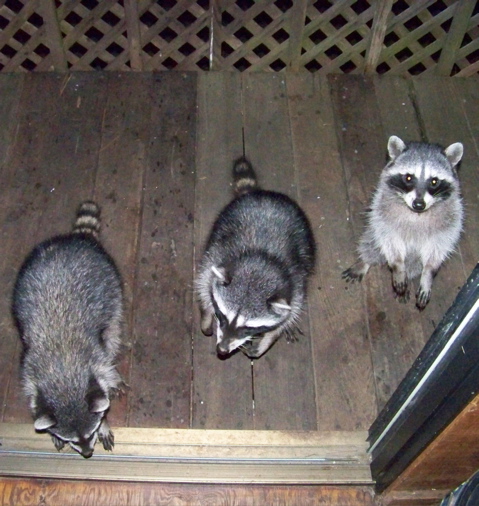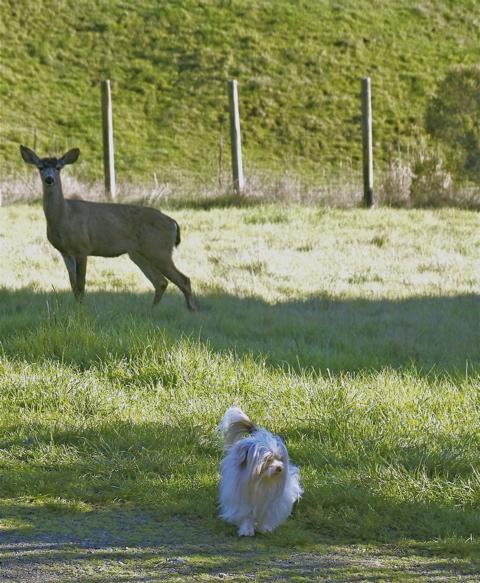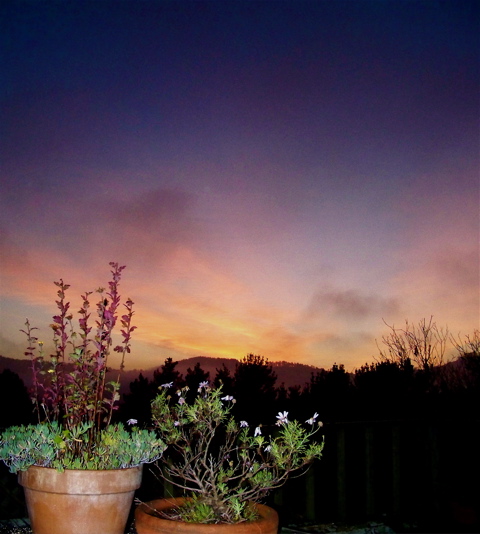Wed 5 May 2010
A day in a small town
Posted by DavidMitchell under Dave Mitchell, Point Reyes Station, West Marin nature, Wildlife
1 Comment
Because few of us in Point Reyes Station have home delivery, the post office has long been the most popular meeting spot in town. On Monday, it was the scene of one of those happy little moments that make small towns great places.
As it happens, postal worker Erin Clark, who was helping out in Point Reyes Station for a day, is a volunteer with a wildlife-rescue group, Rancho Raccoon, headed by Megan Isadore of Forest Knolls.
About a week earlier, Rancho Raccoon received four newly born raccoons that were orphaned when a building was torn down in Oakland. Erin took over raising the newborns when they were less than a week old.
Like any mother, Erin has to periodically check on her young ones, so on Monday she brought them with her when she went to work. There was no risk of the baby raccoons getting into trouble at the post office where they spent the day sleeping in a back room. At 11 days old, their eyes had not yet opened nor were their ears fully developed.
Erin is the only mother the raccoons know, so whenever she picks one up, the baby tries to suckle on her fingers.
Equally picturesque but less cuddly were 15 western pond turtles I counted Monday on two logs in a pond off Cypress Road. The small pond at Anastacio and Sue Gonzalez’s home attracts a variety of wildlife, and on warm days, these turtles emerge to sun themselves.
California’s Department of Fish and Game has designated the western pond turtle a “species of special concern.” Because some pond turtles, especially fertile females, migrate, motor vehicles periodically kill a few. Pesticide runoff, loss of habitat, and introduced predators are also reducing their numbers. Around West Marin, a major threat is from non-native bullfrogs, which eat hatchling and juvenile turtles.
Western pond turtles can be found from the Canadian border to Baja California although in the state of Washington, they almost became extinct around 1990 because of an unidentified of disease. However, they are now making a recovery there thanks to government programs.
As I started down my front steps Monday en route to the post office, I startled a young buck that was lying down, chewing its cud. The deer jumped up and started to quickly walk away, but I began talking to it in a low voice, and it stopped to look at me.
When I stayed put and kept whispering soothingly, the buck relaxed and started scratching fleas. Before long it was grazing. Not wanting to disturb the deer, I had to wait about 10 minutes until it wandered off and I could get to my car and drive into town.
On Sunday I completed a two-week assault on the thistles in my field. I even removed thistles on the edge of three neighbors’ fields since one neighbor’s thistle problem quickly becomes the neighborhood’s thistle problem.
As first described in this blog April 28, a fortnight spent pulling up and cutting down thistles was exhausting and sometimes painful. Several fingers sustained battle wounds, but I expect to fully recover. As of now, I’m storing enough thistles in plastic bags to keep my green-waste container full for another month of pickups.
Eliminating thistles is, of course, a bit like eliminating spiderwebs. Every time the light changes, you spot one you previously missed. All the same, I sort of felt a sense of satisfaction Sunday evening for having persevered in this unpleasant task for two weeks.
The cable guy, Jim Townsend of Horizon Cable
I would have felt even better were it not for one screwup. My cabin is connected to one of the oldest sections of the Horizon Cable system in Point Reyes Station. It’s so old that much of the cable was originally strung along this hill’s barbed-wire fences.
Ever since buying the old system, Horizon Cable has been upgrading it. However, at one corner of my fence, a short length of cable in relatively thin conduit still dangles beside the barbed wire. On Sunday while using loppers to cut down the largest thistles, I reached into a clump and instead cut the cable.
Immediately I alerted Horizon Cable, for although I didn’t much mind not having television, not having access to the Internet was a real drag. I felt cut off from friends and family in faraway places. I couldn’t get my nightly fix of al Jazeera.
Thankfully on Monday morning, Horizon technician Jim Townsend showed up and managed to get me back online despite having to dig up some old-style fittings for my old-style section of the system. I don’t mind being on an antiquated section with part of my cable running along a barbed-wire fence. To me it symbolizes the enduring rusticity of Point Reyes Station.











 When my grandmother was a girl in Canada back around 1880, she was slicing food in the kitchen one day when the knife slipped and cut deeply into a finger.
When my grandmother was a girl in Canada back around 1880, she was slicing food in the kitchen one day when the knife slipped and cut deeply into a finger. Mom emigrated to the United States in 1930, and my parents were living half a block from the Marina Green in San Francisco when I was born in 1943. As a result, many of my parents’ early photos of me were shot beside San Francisco Bay.
Mom emigrated to the United States in 1930, and my parents were living half a block from the Marina Green in San Francisco when I was born in 1943. As a result, many of my parents’ early photos of me were shot beside San Francisco Bay. When my stepdaughter Shaili Zappa, 16, was visiting from Guatemala last month, I told her this story and she was intrigued. (Photo of Shaili and me by Ana Gonzalez)
When my stepdaughter Shaili Zappa, 16, was visiting from Guatemala last month, I told her this story and she was intrigued. (Photo of Shaili and me by Ana Gonzalez) By the way, while most of us know where the Tenderloin is in San Francisco (see Google map at right), many people don’t know the origin of the name.
By the way, while most of us know where the Tenderloin is in San Francisco (see Google map at right), many people don’t know the origin of the name.
 The advertising manager of The West Marin Citizen, Linda Petersen, 61, of Inverness, suffered major injuries last night around midnight when her car hit a utility pole just west of Motel Inverness.
The advertising manager of The West Marin Citizen, Linda Petersen, 61, of Inverness, suffered major injuries last night around midnight when her car hit a utility pole just west of Motel Inverness.










 Retired County Administrator Mark Riesenfeld of Point Reyes Station watches Inverness volunteer firefighter Ken Fox pour batter at the West Marin Disaster Council’s pancake breakfast Sunday.
Retired County Administrator Mark Riesenfeld of Point Reyes Station watches Inverness volunteer firefighter Ken Fox pour batter at the West Marin Disaster Council’s pancake breakfast Sunday. During the fundraiser, oyster farmer Kevin Lunny (center) chats with Marin Magazine writer P.J. Bremier (in dark glasses). In the November issue, Bremer writes at length about the Point Reyes National Seashore’s desire to close down Lunny’s century-old oyster operation. Listening (left of him) is Dolly Aleshire of Inverness. Librarian Jennifer Livingston of Inverness stands in the foreground.
During the fundraiser, oyster farmer Kevin Lunny (center) chats with Marin Magazine writer P.J. Bremier (in dark glasses). In the November issue, Bremer writes at length about the Point Reyes National Seashore’s desire to close down Lunny’s century-old oyster operation. Listening (left of him) is Dolly Aleshire of Inverness. Librarian Jennifer Livingston of Inverness stands in the foreground. Marin County firefighter Tony Giacomini reads off the names of winners in the disaster council’s raffle. Assisting him are his wife Nikki, his son Brandt (who has just drawn a ticket), and Brandt’s brother Ryan (beside him).
Marin County firefighter Tony Giacomini reads off the names of winners in the disaster council’s raffle. Assisting him are his wife Nikki, his son Brandt (who has just drawn a ticket), and Brandt’s brother Ryan (beside him). I’m the Campolindo Drive liaison to the disaster council. That basically means in case of a disaster, such as a major earthquake, I’m supposed to radio my area coordinator, Kate Kain of Point Reyes Station, and let her know if there are any serious problems on this road.
I’m the Campolindo Drive liaison to the disaster council. That basically means in case of a disaster, such as a major earthquake, I’m supposed to radio my area coordinator, Kate Kain of Point Reyes Station, and let her know if there are any serious problems on this road.


 Having changed its fare in the past year, Café Reyes in Point Reyes Station on some days now resembles a newspaper hangout.
Having changed its fare in the past year, Café Reyes in Point Reyes Station on some days now resembles a newspaper hangout. “According to a 2007 survey, local community papers are the primary source of information by a two-to-one margin over the next most popular medium,” television….
“According to a 2007 survey, local community papers are the primary source of information by a two-to-one margin over the next most popular medium,” television….